
Overview
As a revenue-driven business, publishers need to keep their bottom line top-of-mind when selecting an online video platform (OVP). The era of traditional OVPs and standard hosting is giving way to a brave new world of monetization-first, publisher-focused OVPs that bring more sophisticated monetization and content automation to the table.
Whether you’re looking to launch a video program from scratch, refine and scale an existing library, or broadcast live events online, this guide will help you identify the foundational elements you need to sustain and grow your business — so you can find your best OVP match.
What is an Online Video Platform?
An OVP is a technology solution that provides a wide array of content management capabilities for video. While early OVPs focused mainly on video hosting and delivery, many platforms today offer many more features, including the creation and editing of video content, management of video libraries and playlists, streaming and broadcasting options, automatic tagging and syndication, and customizing video players and their behavior. Some OVPs also offer monetization capabilities to help increase revenue.
The benefit of using an OVP is consolidating all of your video management in one place. In most cases, this is grossly more cost-effective than building the technology yourself or working with several different vendors for various point solutions which would, in turn, result in accumulating fees and extra cost.
Sizing up the online video space
The value proposition behind an OVP for publishers is simple: load videos into a player, wrap ads around the content, and display it on a webpage to users. Yet, for decades, legacy OVP providers have focused almost exclusively on the first part of that process, while ignoring the need for revenue generation or scalable content management tools. These oversights have led to two major gaps in the market.
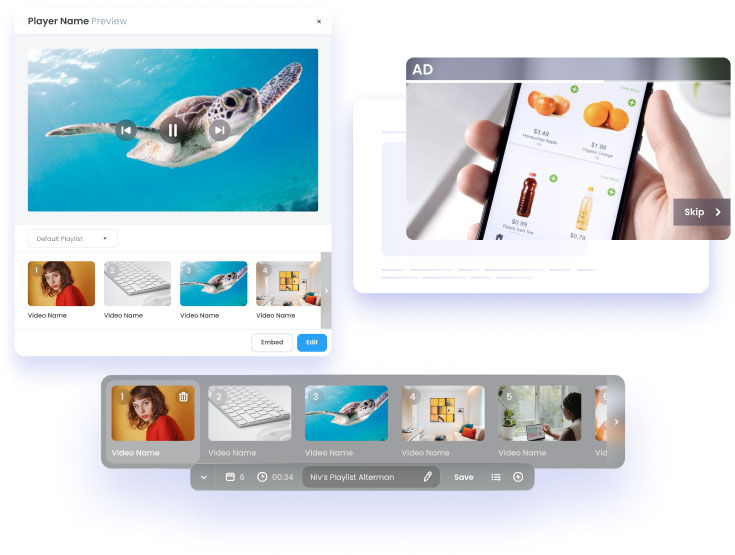
Quality long-form video on all pages
Consumer appetite for video seems endless: In 2023, people are watching an average of 17 hours of online video per week. But, producing original content can be daunting (and expensive). Despite advances in AI-powered, no-code software, many legacy OVPs still lack these automations that, for example, could automatically turn text articles into video clips, or syndicate relevant playlists.
Publishers have been left with manual work flows and workarounds and an uphill battle to scale their video supply to 100% of their pages. An OVP that offers an endless amount of additional video sources while having the technology to match this content to the right page in a non-manual way will directly impact the publisher’s ability to earn meaningful revenue.
Ad server and yield engine functionality built-in
Because legacy OVPs often treat monetization as an afterthought, it’s been hard for publishers to fully capitalize on video. This is especially true for live streaming, which confronts the challenge of managing high-stakes, millisecond auctions during periods of peak traffic. But even run-of-the-mill short video content has been ill-served by traditional solutions.
Without ready, integrated demand sources to tap into, publishers have to source their own advertisers through direct sales, which requires extensive headcount and resources. Some OVPs also force publishers to choose between running their own demand or the platform’s rather than being agnostic and having an engine that will automatically choose the demand source that will generate the most revenue in a given auction.
Main categories of OVPs
Legacy OVPs
Limited built-in monetization features and often manual curation processes. Contextual technology powers strong engagement but only a fraction of potential page revenue.
Examples:
JW Player, Brightcove,
YouTube, Wistia, Vidyard,
Panopto
Monetization-first OVPs
Built-in yield engine and ad server, with robust demand management and detailed revenue reporting. Offers solutions for higher video coverage such as contextual technology, content marketplaces, and automation which makes it easy to migrate video content and scale video engagement at a lower cost.
Examples:
EX.CO, Aniview
Streaming OVPs
Built for sophisticated live broadcasting needs, with varying quality of monetization layers. Many OVPs will require you to bring your own content feed.
Examples:
Vimeo, Dacast, Kaltura,
YouTube, Sprout Video
What to look for in an OVP Partner
There are several basic criteria that publishers should evaluate in an OVP regardless of their specific video ambitions. Whether you’re looking to focus on short-form content or live streaming, you want to make sure your partner fulfills not only the technical requirements, but also the foundational pillars to help grow your business.
1. Monetization
If you’re a publisher that relies on advertising revenue, the first thing you should look for in an OVP is how much they support revenue generation. It’s no longer enough to merely host your videos and hope for incremental gains.
- Does the provider have integrated demand offerings, and will you be able to plug in all your direct and programmatic demand?
- Do they allow you to use both demand sources and if so, will they let your demand have equal opportunity in every auction?
- What do their specific yield engine and ad server capabilities look like and are they built-in?
- How do their average RPMs and fill rates compare with industry benchmarks?
Want to know what you could earn from your OVP?
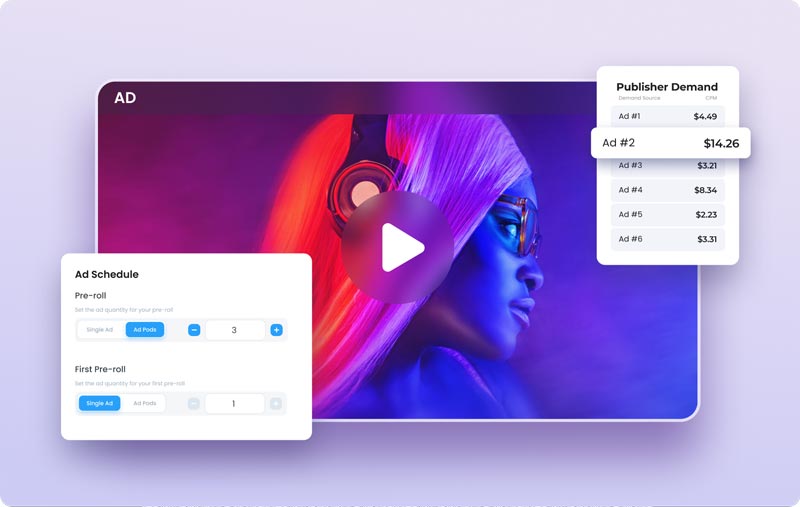
2. Video management
Management of assets is at the core of every OVP. How well the platform allows you to customize the management of those assets is the key differentiating factor. Look for a vendor that offers the ability to easily upload video content manually or via MRSS and API.
- Is there cloud hosting available?
- Is a YouTube integration included so you can easily repurpose your YouTube content across your site?
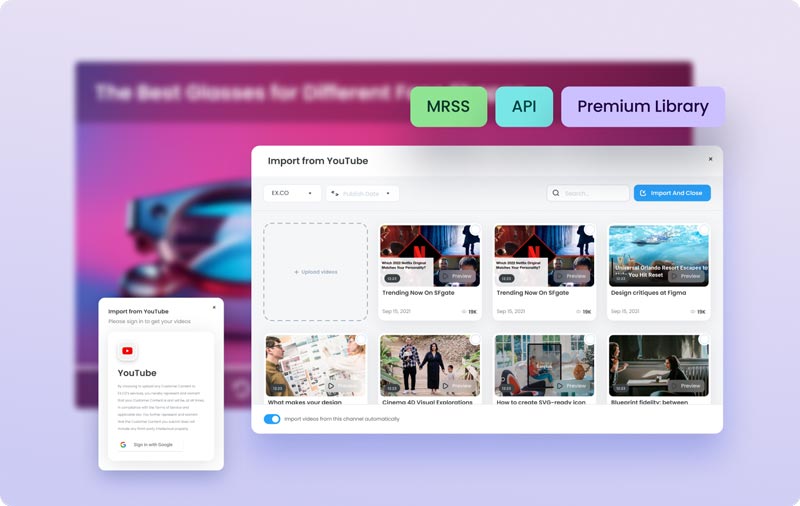
3. Content
Naturally, premium content is at the center of every solid video strategy and preferred user experience, and thus access to such content is crucial. Additionally, users expect a seamless experience, and today that includes intelligent playlists and personalized recommendations. That might include AI that matches videos contextually with relevant articles.
- What contextual data points is the OVP collecting to power your playlists, and how is this user experience?
- Are the playlists dynamic and can they be easily changed for specific pages, multiple sections, or many domains at once?
- Does the OVP offer a marketplace for access to new video content if you don’t have any or run out?
- Are you personally able to embed, delete, or edit video content at any point in time?
- Can you change the video content to target users based on page type, user segment, or business goals?
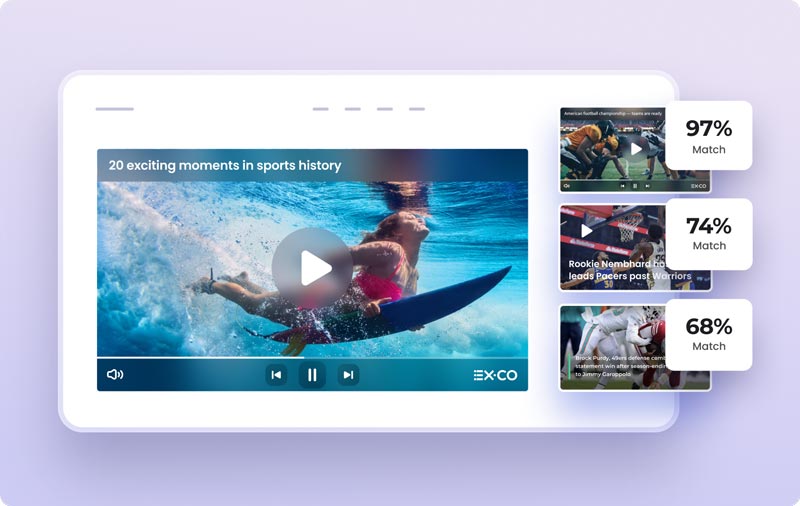
4. Video player
Of course, the flexibility you have to customize video players is just as important as the management of the content itself. Be sure the vendor you choose gives you full reign for customization here and let’s not forget that today’s consumers are conditioned by social media. Personalizing the video consumption experience on par with any news feed or social channel can make or break whether or not a user stays on the page.
- Can you create new players whenever you wish?
- Can you customize a video player by changing its format, colors, or behavior? Can you add your logo to it?
- Does the vendor offer sticky players for optimal viewability on mobile?
- Do you have the ability to control when the players start, pause, and stop based on whether or not the player is in view?
- Are you able to deliver a vertical video option tailored to mobile user habits, similar to TikTok?
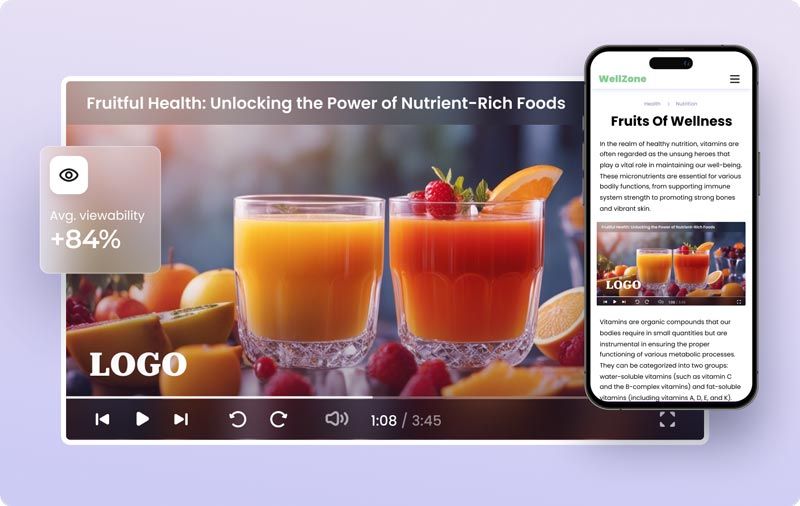
5. Coverage
If all revenue signs are looking positive, this number can help validate (or disprove) your hunch. A publisher’s revenue potential is a function of how many page views it can supply with quality video content.
- What is the average percentage of pages with video across the OVP’s publisher network?
- What are the engagement rates like?
- Does the OVP offer additional high-quality video content if you don’t have enough or run out of your own?
AVG. VIDEO COVERAGE
6. Mobile app support
Of course, many publishers have their own mobile apps and if you want to showcase online video there also, you’ll need to find an OVP that has the ability to support them.
- Can the OVP support webview apps?
- Do they offer a native SDK, and is the integration seamless?
7. Business model
Every OVP you speak to will likely have a different business model and it’s crucial that you find one that meets your immediate needs. Some companies will charge upfront costs and fees based on usage while others will use a “rev share” model in which they will share a percentage of revenue with you based on performance. Monetization-first OVPs are primarily focused on the client earning revenue and helping the business grow therefore, these types of businesses will offer a rev share.
- Do you have to pay to start using the platform?
- How quickly will you see returns?
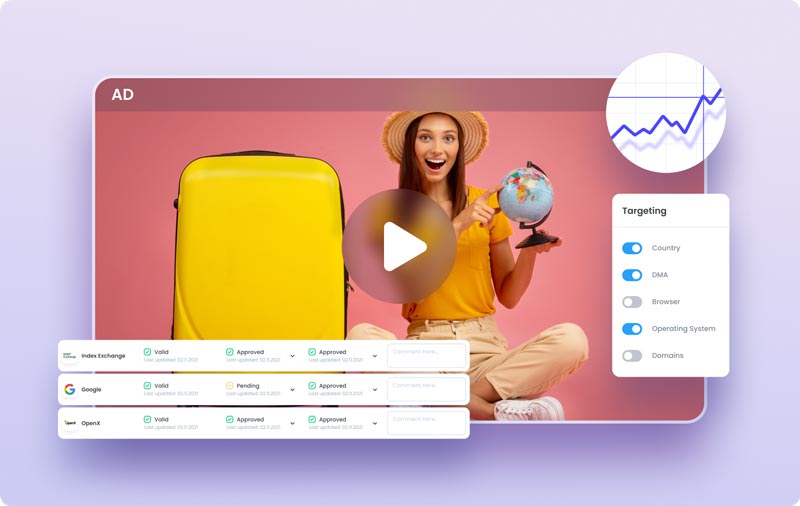
8. Migration and automation
Before getting too deep with any one provider, you want to know if a technical fit is feasible. Publishers often imagine a lot of pain when thinking of switching their video management platform, but it doesn’t have to be that way.
Also, not all automation is created equal. Dig in and really understand each OVP’s ability to help with things like content tagging, cataloging, indexing, and playlist and feed creation. Map out your specific workflows and API integrations and understand the manual work it will take to transfer your thousands of videos across dozens, maybe even hundreds, of domains.
- What tools does the OVP provide to make the migration process as easy as possible?
- Does the OVP offer flexible APIs and a robust automation engine that can minimize manual tagging work, and accelerate your time to parity and growth?
- What work will you have to do in advance of the integration?
- How seamless is the integration process?
- What will you have to do manually moving forward vs. what will be automated by the OVP?
Avg. time needed before providing meaningful value to publisher
9. Support
Don’t overlook the importance of a strong customer success team. Legacy providers can be notorious for slow response times or non-existent service level agreements (SLAs). Be diligent in confirming these service agreements and seek out peer reviews to understand each OVP’s ability to support when an issue arises. In digital media, every second of outage bears a direct cost in lost revenue.
- Are there any self-serve options?
- Can you be granted access to the backend dashboard if things go awry and you need to make changes at a moment’s notice?
10. Analytics
To build an audience, you need feedback on what’s resonating. Look under the hood of each OVP to see what native reporting it supports.
- Do these track the KPIs that matter to you, or will you need to build custom reports?
- Does the data go beyond engagement to show ad viewability, RPMs, etc?
- Are you able to get log-level reporting?
- What about player performance?
- Is the overall data robust, or will you need to layer on third-party analytics?
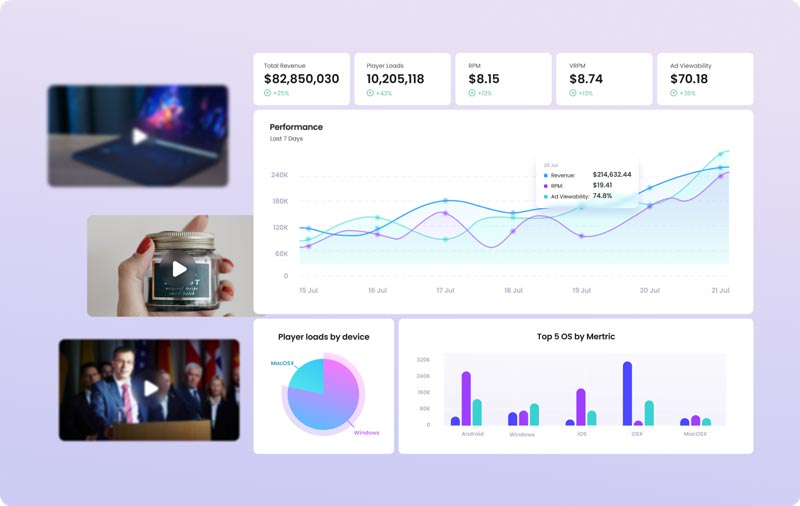
11. Subscription
One of the most valuable actions a user can take is opting to receive emails from your team. Sign-ups might not immediately come to mind with video, but it can actually be a highly effective moment to convert engaged visitors.
- Can the OVP leverage video overlays or interactive end screens to drive your loyalty and subscription goals?
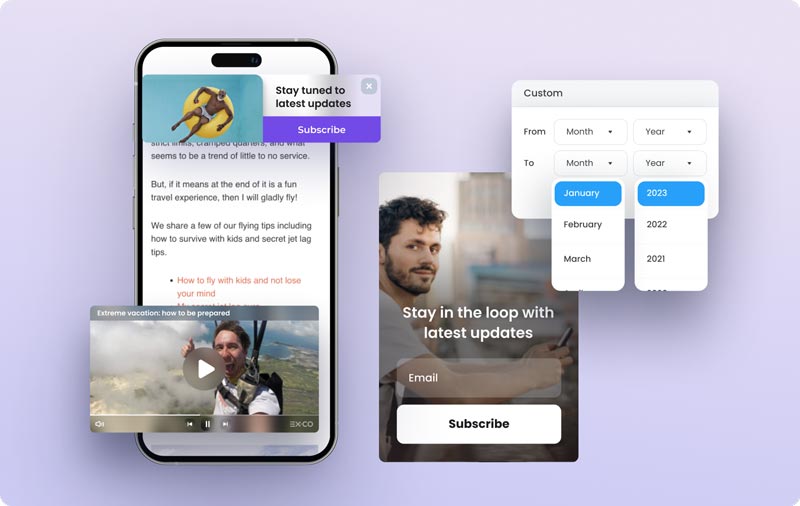
Finding the best match for your OVP needs
While this guide highlights some essential factors for any OVP decision, there are likely other considerations you need to assess and evaluate. At the same time, you don’t want to overwhelm your team with so many options and variables that might lead to a state of paralysis. Here’s a simple framework to keep your decision process moving.
-
Identify your top five factors based on current business goals
-
Eliminate any OVPs with gaps among those top factors
-
Compare shortlist on features, pricing, demos — remove stragglers
-
Evaluate long-term scalability and narrow your list to two options
-
Conduct a cost-benefit analysis and seek peer feedback
-
Finalize selection and sign contract
Getting Started
In recent years, the online video world has flipped. Publishers no longer have to pay seven-figures for a standard license fee to merely stream or catalog a video. Instead, you can deploy and scale video efficiently, at low to zero cost. A new breed of tech companies are helping publishers replace their legacy OVPs with technology that delivers higher revenue without hefty upfront fees, and reduces the reliance on manual video management.
There’s rapidly growing demand for consumer video, and choosing the right OVP partner can make all the difference – between a sub-par UX that sends bounce rate skyrocketing, or an elegant player that boosts engagement and revenue many times over.
Get in touch
Please leave your details and a specialist from our team will reach out.
